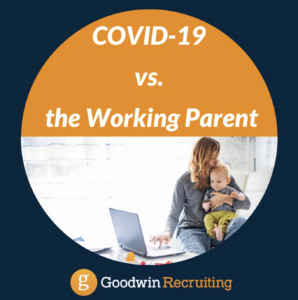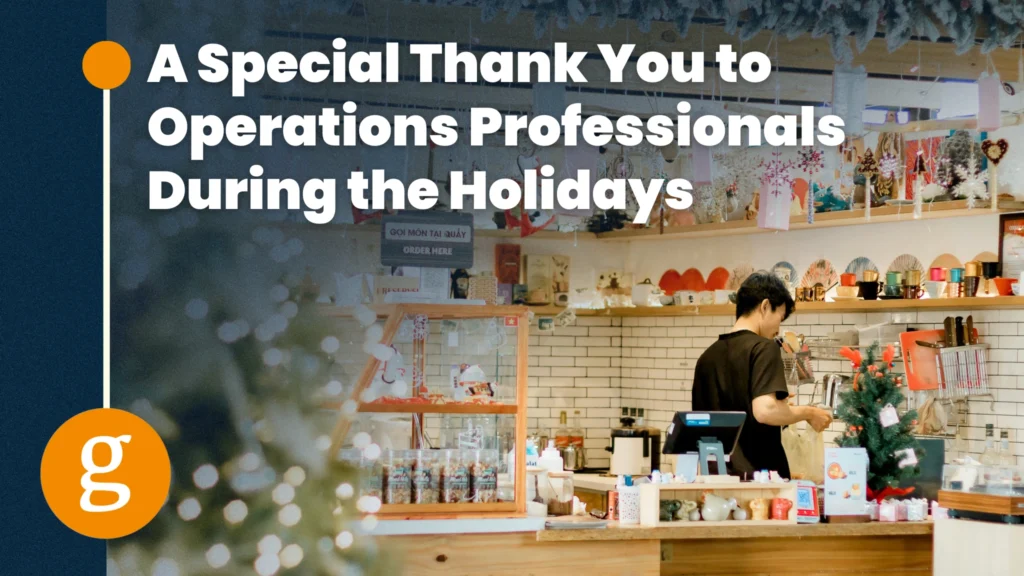COVID-19 vs. the Working Parent
Goodwin Recruiting | Career Advice, Hiring Advice, Opinion, Opportunity for All | May 18, 2021

COVID-19 – the global pandemic of our generation. Some of us were in the middle of the job hunt or in the process of securing new jobs when the pandemic hit full force. Schools and daycares were shut down; we were all on complete lockdown. Eventually, we have been allowed out of our homes, and many are able to go to work again. But how does a working parent do that with small children at home while daycares and schools are still closed?
There has been research on how COVID-19 not only affected single parents but parents in general. The pandemic has unfortunately amplified a preexisting bias towards working parents.
According to USA facts, 15% of women and 2% of men who have lost jobs during the pandemic were unable to work because of childcare issues. In April of 2020, only 55% of mothers with school-aged children were actively working, compared to a normal rate of about 70% of mothers with school-aged children pre-pandemic.
Personal Reflections of a Working Parent
Working parents were quickly forced into a battle to keep their jobs, be successful, teach their children, and keep everyone safe and healthy. Children’s schools shut down pretty hastily without a plan of how to distribute schoolwork, how to teach them remotely, etc. Eventually, plans came into place that relied heavily on parental involvement. Parents around the country were logging into online portals, printing paperwork, mapping out zoom schedules, and teaching their children how to navigate this completely new world of education. All while many employers expected a constant presence at a quiet, productive space from 8-5. Many parents felt failure on all fronts.
During the height of the pandemic, an astonishing 39% of people living in low-income households lost their jobs in March 2020 alone. According to Brookings.edu, due to their ‘concentration in low-wage and face-to-face jobs, these layoffs hit women especially hard. While many higher-wage jobs could transition from an in-person to a remote work environment, that is not the case for most low-wage jobs that rely on the interaction between customers and workers, such as retail sales and hospitality — two of the most common occupations among low-wage women. The unemployment rate for women jumped by more than 12 percentage points between February and April while the rate for men increased by less than 10 percentage points.’
Job seekers have relayed similar interview stories during this time. Before being given an official offer, one candidate was asked, “I know you have kids, but how do you plan on working if you’ve got kids at home? Do you have stable daycare secured? I cannot give you the offer without it.” These questions were unlawful, but many candidates have ignored these red flags in order to get back to work.
Another area of pandemic stress for parents has been increased child care costs due to supply and demand issues. One candidate told the story of her excitement when her family’s daycare announced their reopening. But there was a catch — they increased their prices by 40% because of “supply and demand.” If you couldn’t afford their rates, there were many other “essential workers” trying to find daycare. Unfortunately, this practice was commonplace throughout the country. According to Care.com, 72% say they spend 10% or more of their household income on childcare. And more than half of families (55%) report that they spend at least $10,000 per year on childcare, which is more than the average annual cost of in-state college tuition ($9,410) per College Board.
Source: USAfacts.org
On top of the financial and work stresses placed on parents across the country, there were many other new problems that parents had to deal with. Active and social children got “locked” in their house. The meltdowns and the stress of these changes for young children have been challenging. On top of all that, parents became “teachers,” “chefs,” “camp counselors,” and “safety patrols” 24 hours a day.
Tough Questions for the Working Parent:
How can we change this narrative? How can we give parents back control of their careers? According to the US Census data in December of 2020, 40% of the workforce are parents. As a society, do we give working parents the time they need and adjust time management expectations to be successful in the home and at work? If we do that, how will that affect those who made the decision not to have children? Will they feel like they are being discriminated against? There is no easy solution to this question — there are just facts that COVID-19 has put a financial burden on everyone, but some have been hit harder than others.
In addition to giving parents their careers back, our society needs to evaluate childcare opportunities. Parents who are required to be in place at a job rather than working remotely have had to pay the fees associated with the supply and demand. Is there a way to bring childcare back to levels that are more financially feasible for the parent?
Are you a parent looking to get back into the workforce? Let Goodwin Recruiting help. Take a look at our open jobs, and let us help you figure out your next career move as you navigate work, family, and everything in between.
Share This Article














































